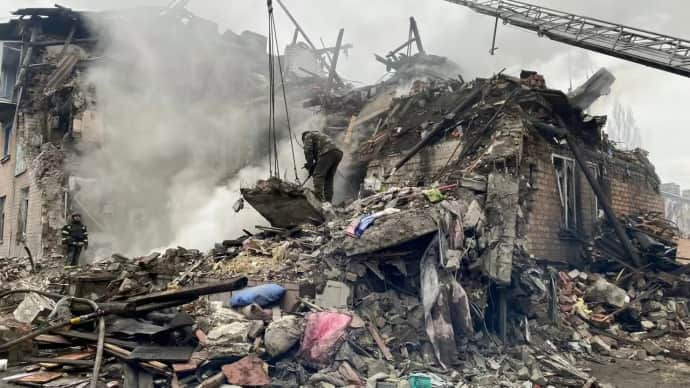Daily Flyer - November 30, 2023
A voice of Ukraine to the West

Russian attack on Novohrodivka: death toll rises, rescue workers are looking for family under rubble

Rescue workers have uncovered the body of another man from under the rubble of a residential building in the city of Novohrodivka, Donetsk Oblast, which was hit by a Russian missile. The rescue operation is ongoing. A family might be still trapped under the rubble: a 33-year-old woman, a 38-year-old man and an 8-year-old girl.
Russians attacked Kherson Oblast, killing three people
Tragically, on November 30, Russian forces conducted a shelling in Kherson Oblast, resulting in the loss of three lives and injuries to several individuals. The head of the Kherson Oblast Military Administration, Oleksandr Prokudin, along with Roman Mrochko, Head of Kherson City Military Administration, provided details on the incident.
The initial report indicated that the Russian army shelled the village of Sadove, leading to the unfortunate death of a 59-year-old woman. Subsequent updates revealed that two additional individuals, aged 53 and 67, also lost their lives in the same attack.
In the city of Kherson, specifically in the Korabel microdistrict, a 71-year-old man sustained injuries due to Russian shelling at approximately 09:30. The man, from Kherson, sought medical attention after experiencing blast trauma, chest injuries, and injuries to the face. While he received immediate medical care, he will undergo further treatment on an outpatient basis.
This distressing incident underscores the human toll and indiscriminate nature of the conflict, with innocent civilians facing the brunt of the hostilities. The international community continues to monitor and condemn such attacks, emphasizing the urgency for a peaceful resolution to mitigate the suffering of those affected by the ongoing conflict.
Russia deploys new airborne troops division in Ukraine
On November 30, UK intelligence reported significant developments in Russia's military deployment, revealing the deployment of a newly formed division of airborne troops in the occupied part of Kherson Oblast. This information was shared through a Twitter update by UK Defence Intelligence, as reported by European Pravda.
The report indicated that Russia has initiated the deployment of the recently re-established 104th Guards Airborne Division in Ukraine, with a particular focus on the occupied territory of Kherson Oblast. Russian Defence Minister Sergei Shoigu had announced plans in August 2023 to revive this division, which had been reduced to a brigade-size formation in 1998. The UK intelligence further specified that the 104th Division's subordinate units likely include the 337th Regiment and the 52nd Artillery Brigade.
However, a notable point from the intelligence update highlighted concerns about the level of training among the fighters from the 104th Division. The training was noted to be below the standards typically associated with "elite" airborne troops. Colonel General Mikhail Teplinsky, appointed as the commander of the Dnieper (Dnipro) grouping since October, is expected to scrutinize the division.
This intelligence provides insight into Russia's ongoing military activities in the region and suggests a strategic shift with the deployment of the 104th Guards Airborne Division. The assessment of insufficient training raises questions about the readiness and effectiveness of this division in the ongoing conflict. It remains a crucial development for monitoring the evolving dynamics of the situation in Ukraine and the broader geopolitical context.
Russians export Ukrainian grain to Iran and Syria through Crimea
Disturbing reports from the National Resistance Center (NRC) indicate that the Russians are involved in the export of Ukrainian grain to Syria and Iran through the ports of occupied Crimea. This activity, which is highlighted by the NRC, raises concerns about the exploitation of local resources and the manipulation of market dynamics.
According to the NRC, the transport of Ukrainian grain to Syria and Iran is facilitated by dry cargo ships, namely Zafar and Matros Koshka, operating from the ports of the temporarily occupied Crimea. The process involves taking grain from local farmers at a fixed price below the market rate, and then reselling it at the market price. The surplus profit is allegedly pocketed by the Russian entities involved.
Additionally, the NRC reports that farmers are subjected to restrictions, being forbidden to sell their products without permission from the Russian authorities. This implies a level of control and exploitation that adds another layer to the complex dynamics in the region.
Such activities not only have economic implications for the affected farmers but also contribute to the broader geopolitical tensions surrounding the occupation of Crimea. The situation underscores the multifaceted challenges faced by local populations in regions impacted by conflict, where economic exploitation and control further complicate an already dire humanitarian landscape. Monitoring and addressing these issues are crucial steps in fostering stability and justice in the affected areas.

